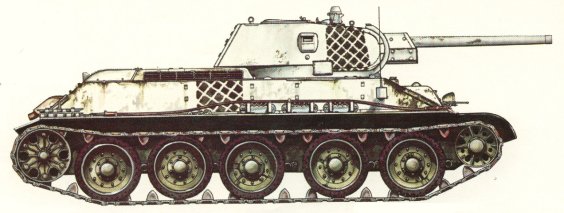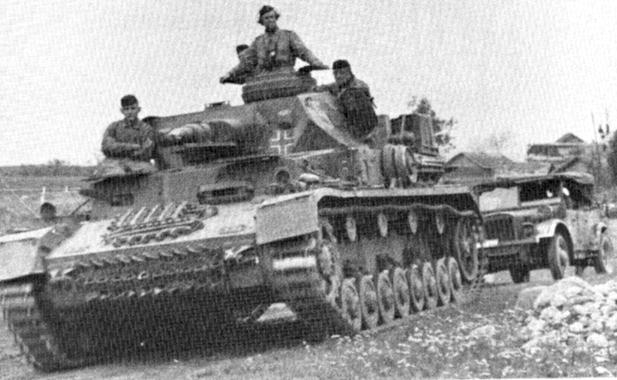
For most people, battles of the Operation Barbarossa in
1941, are a long row of German victories, eventually stopped at the gates
of Moscow, where the weather stopped Hitler and his men. But, especially in the
Autumn of 1941, there were several examples of engagements with a different outcome. Even
though the production of T-34 tanks had begun in 1940, not more than 115 vehicles had been
completed by January 1st of 1941. At dawn on June 22nd of 1941, a total of 967 T-34/76
medium and 508 KW-I heavy tanks had been built. This can be compared with 439 of German
medium PzKpfw IV tanks, armed with the short-barreled 75mm KwK 37 L/24 guns and 965 PzKpfw
III, armed with either a 37mm KwK L/46 gun or a 50mm KwK L/42 gun.
As you can see it wasn't a lack of modern tanks which led to the enormous Russian losses
in the opening stages of the fighting on the Eastern Front, but it was poorly trained and
inexperienced crews of badly organized tank formations, which proved to be decisive.
Already after a month of fighting with Russians with the their heavy losses decided not to
form new units as a replacement for destroyed units, but instead reorganize the remaining
and newly built tanks into smaller units, Tank Brigades. These consisted of 67 tanks,
which formed two battalions equipped with KW-I heavy tanks, T-34's and BT tanks along with
some additional light tanks. Although this was the official organization, many tank
brigades formed during mid and late 1941 were heavily reduced in number of tanks. The
lowest number of tanks in a brigade is said to have been just 15 vehicles!

One of the brigades set up in August of 1941, was the 4th Tank Brigade. Formed in Prudboi,
north of Stalingrad with its Tractor Factory, which allowed the brigade to have a total of
60 tanks of which 22 were T-34's. Colonel Mikhail Katukov was given the command of the
brigade. Commander of the 1st Bttn was Captain Gusiev and of the 2nd Bttn Lieutenant
Raftopullo. All 22 T-34's along with 7 KW-I was issued to the 1st Bttn, while Raftopullo's
2nd Bttn was equipped with 31 BT-7 and BT-7M tanks.
On September 28th, the 4th Tank Brigade was loaded and transported by rail to Kubinka
outside Moscow to take part in the upcoming defensive battle. On the way to Moscow was
also the German 2nd Panzergruppe under the command of Heinz Guderian. The 2nd Panzergruppe
had been very successful in its drive on Moscow and the capture of Moscow seemed to get
closer and closer.

On October 4th, Captain Gusiev's 1st Bttn was ordered to move out to the town of Mtsensk,
which lay in a direct way of the 2nd Panzergruppe's way to Moscow. Two Russian patrols
were sent out on reconnaissance, and on the next day, patrols attacked elements of a
German forward unit. On the night of October 6th and 7th the whole brigade was transferred
to a wooden area called Piervyi Voin along the road between Orel and Mtsensk. Here they
got into position, and during this night the first snow fell.

T-34/76 Model 1941. The black stripe pattern was meant to brake up the silhouette of the
tank in snow.
At dawn a major group of German tanks, half-tracks and lorries was discovered. Actually
this was the German 4th Panzer Division under the command of Lord von Landermann. As soon
as the Germans were in range, the Russians opened fire. One platoon of T-34's under
Lieutenant Kukarin drove with full speed attacking the flank and spread havoc amongst the
PzKpfw III's. Four PzKpfw III's were quickly knocked out, but after some time Kukarin had
to call off the attack due to ammunition shortage. In the same time, four T-34's and three
KW-I's attacked on the right flank. The attack lasted until noon, and ended with Russians
withdrawing after knocking out total of 43 German tanks & halftracks. The 4th Tank
Brigade's losses consisted of only 6 tanks. For this and also many following victories
many crews and commanders were awarded.
In total, the 4th Tank Brigade knocked out 133 tanks along with small numbers of
self-propelled guns, armored cars, halftracks and lorries. Their actions played an
important part in The Battle for Moscow. This was the reason why the unit received the
elite unit status and was renamed the 1st Guards Tank Brigade.
It is interesting to note what Guderian wrote about the combat engagement at Piervyi Voin:
"On October 6th, our headquarters was moved up to Sevsk, the 4th Panzer Division
was attacked by Russian tanks and had some difficult hours. This was the first time as the
T-34's great superiority was clearly discovered. The division received heavy casualties.
The fast advance on Tula which we have planned is temporarily abandoned. The description
of the quality and especially the new tactical use of the Russian tanks was very worrying.
Our defensive weapons, when available, were only effective against the T-34 when the
situation was unusually advantageous. The short gun of the PzKpfw. IV was only effective
when attacking the T-34 from the rear and at short range, and even then the shell had to
hit the engine plates to knock it out. This required great skills by the crew to both
maneuver into the right position and then fire with exact accuracy. The Russians launched
frontal attacks with infantry as they sent in tanks in mass-formation on our flanks. They
learned."
Guderian visited the battlezone and confirmed the Russian superiority.
"The tanks which were knocked out on both sides were still there. The Russians
had inflicted a lot more damage than they had suffered themselves."
Guderian also writes that this engagement was a psychological blow for the German Panzer
commanders, the Russian tank units had been superior to the reckless German troops both
tactically and materially. The superiority of the Russian tank formations increased when
the snow came in early October. The German units had in contrast with the Russians nor the
proper material or experience of winter warfare. But an important note is that out of the
total 890 Russian tanks committed to The Battle for Moscow (they threw in everything they
had, including surviving T-35 heavy tanks serving with Siberian skitroops), only 100 were
T-34's and KW-I tanks, while the rest were mainly T-26 and BT tanks.

Russian and German tanks in use in October 1941
| Description | T-34/76 M1940 | T-34/76 M1941 | PzKpfw IIIH | PzKpfw IVE |
| Weight | 26,8 tons | 28 tons | 21,6 tons | 21 tons |
| Gun | 76,2mm L/30,5 | 76,2mm L/41 | 50mm L/42 | 75mm L/24 |
| Penetration 500m | 62mm | 69mm | 46mm | 39mm |
| Penetration 1.000m | 56mm | 61mm | 36mm | 35mm |
| Frontal armor | 45mm | 60mm | 30mm | 50mm |
Source:
* SPHF Mag. "PANSAR" Issue #85/1
* Keegan, John; Barbarossa: invasion of Russia 1941
* Special thanks to: George Parada - Provider of PzKpfw. III and IV pictures.